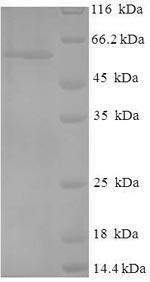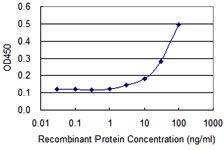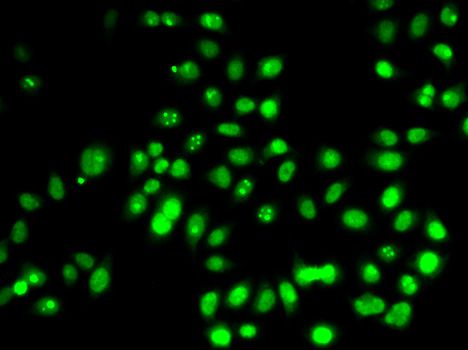References
Analysis of the gene coding for the murine cellular tumour antigen p53.Bienz B., Zakut-Houri R., Givol D., Oren M.EMBO J. 3:2179-2183(1984)
A single gene and a pseudogene for the cellular tumour antigen p53.Zakut-Houri R., Oren M., Bienz B., Lavie V., Hazum S., Givol D.Nature 306:594-597(1983)
Cloning and expression analysis of full length mouse cDNA sequences encoding the transformation associated protein p53.Jenkins J.R., Rudge K., Redmond S., Wade-Evans A.Nucleic Acids Res. 12:5609-5626(1984)
Immunologically distinct p53 molecules generated by alternative splicing.Arai N., Nomura D., Yokota K., Wolf D., Brill E., Shohat O., Rotter V.Mol. Cell. Biol. 6:3232-3239(1986)
Primary structure of DNA complementary to mRNA of murine oncoprotein p53.Chumakov P.M.Bioorg. Khim. 13:1691-1694(1987)
Cell cycle in DNA-PKcs knock-out mice.Araki R., Fukumura R., Fujimori A., Tatsumi K., Abe M. DNA-dependent protein kinase is not required for the p53-dependent response to DNA damage.Jimenez G.S., Bryntesson F., Torres-Arzayus M.I., Priestley A., Beeche M., Saito S., Sakaguchi K., Appella E., Jeggo P.A., Taccioli G.E., Wahl G.M., Hubank M.Nature 400:81-83(1999)
Characterization of DNA-PKcs null mutant SX9.Araki R., Fukumura R., Fujimori A., Tatsumi K., Abe M. p53 in 129-SVJ mice.Fujimori A., Abe M.
Loss of heterozygosity and mutational alterations of the p53 gene in skin tumours of interspecific hybrid mice.Burns P.A., Kemp C.J., Gannon J.V., Lane D.P., Bremner R., Balmain A.Oncogene 6:2363-2369(1991)
Detection of a transformation-related antigen in chemically induced sarcomas and other transformed cells of the mouse.DeLeo A.B., Jay G., Appella E., Dubois G.C., Law L.W., Old L.J.Proc. Natl. Acad. Sci. U.S.A. 76:2420-2424(1979)
p53 is involved in the p120E4F-mediated growth arrest.Sandy P., Gostissa M., Fogal V., Cecco L.D., Szalay K., Rooney R.J., Schneider C., Del Sal G.Oncogene 19:188-199(2000)
Characterization of cells and gene-targeted mice deficient for the p53-binding kinase homeodomain-interacting protein kinase 1 (HIPK1)
.Kondo S., Lu Y., Debbas M., Lin A.W., Sarosi I., Itie A., Wakeham A., Tuan J., Saris C., Elliott G., Ma W., Benchimol S., Lowe S.W., Mak T.W., Thukral S.K.Proc. Natl. Acad. Sci. U.S.A. 100:5431-5436(2003)
Axin stimulates p53 functions by activation of HIPK2 kinase through multimeric complex formation.Rui Y., Xu Z., Lin S., Li Q., Rui H., Luo W., Zhou H.-M., Cheung P.-Y., Wu Z., Ye Z., Li P., Han J., Lin S.-C.EMBO J. 23:4583-4594(2004)
Mapping of phosphomonoester and apparent phosphodiester bonds of the oncogene product p53 from simian virus 40-transformed 3T3 cells.Samad A., Anderson C.W., Carroll R.B.Proc. Natl. Acad. Sci. U.S.A. 83:897-901(1986)
The p53 tumour suppressor protein is phosphorylated at serine 389 by casein kinase II.Meek D.W., Simon S., Kikkawa U., Eckhart W.EMBO J. 9:3253-3260(1990)
p53 is covalently linked to 5.8S rRNA.Fontoura B.M., Sorokina E.A., David E., Carroll R.B.Mol. Cell. Biol. 12:5145-5151(1992)
Negative control of p53 by Sir2alpha promotes cell survival under stress.Luo J., Nikolaev A.Y., Imai S., Chen D., Su F., Shiloh A., Guarente L., Gu W.Cell 107:137-148(2001)
Identification and characterization of murine mHAUSP encoding a deubiquitinating enzyme that regulates the status of p53 ubiquitination.Lim S.-K., Shin J.-M., Kim Y.-S., Baek K.-H.Int. J. Oncol. 24:357-364(2004)
Differential effect of ik3-1/cables on p53- and p73-induced cell death.Tsuji K., Mizumoto K., Yamochi T., Nishimoto I., Matsuoka M.J. Biol. Chem. 277:2951-2957(2002)
Direct interaction with and activation of p53 by SMAR1 retards cell-cycle progression at G2/M phase and delays tumor growth in mice.Kaul R., Mukherjee S., Ahmed F., Bhat M.K., Chhipa R., Galande S., Chattopadhyay S.Int. J. Cancer 103:606-615(2003)
PML regulates p53 stability by sequestering Mdm2 to the nucleolus.Bernardi R., Scaglioni P.P., Bergmann S., Horn H.F., Vousden K.H., Pandolfi P.P.Nat. Cell Biol. 6:665-672(2004)
PRAK is essential for ras-induced senescence and tumor suppression.Sun P., Yoshizuka N., New L., Moser B.A., Li Y., Liao R., Xie C., Chen J., Deng Q., Yamout M., Dong M.Q., Frangou C.G., Yates J.R. III, Wright P.E., Han J.Cell 128:295-308(2007)
Hzf Determines cell survival upon genotoxic stress by modulating p53 transactivation.Das S., Raj L., Zhao B., Kimura Y., Bernstein A., Aaronson S.A., Lee S.W.Cell 130:624-637(2007)
Novel homeodomain-interacting protein kinase family member, HIPK4, phosphorylates human p53 at serine 9.Arai S., Matsushita A., Du K., Yagi K., Okazaki Y., Kurokawa R.FEBS Lett. 581:5649-5657(2007)
CHD8 suppresses p53-mediated apoptosis through histone H1 recruitment during early embryogenesis.Nishiyama M., Oshikawa K., Tsukada Y.I., Nakagawa T., Iemura S., Natsume T., Fan Y., Kikuchi A., Skoultchi A.I., Nakayama K.I.Nat. Cell Biol. 11:172-182(2009)
Trim24 targets endogenous p53 for degradation.Allton K., Jain A.K., Herz H.M., Tsai W.W., Jung S.Y., Qin J., Bergmann A., Johnson R.L., Barton M.C.Proc. Natl. Acad. Sci. U.S.A. 106:11612-11616(2009)
A large intergenic noncoding RNA induced by p53 mediates global gene repression in the p53 response.Huarte M., Guttman M., Feldser D., Garber M., Koziol M.J., Kenzelmann-Broz D., Khalil A.M., Zuk O., Amit I., Rabani M., Attardi L.D., Regev A., Lander E.S., Jacks T., Rinn J.L.Cell 142:409-419(2010)
p53 opens the mitochondrial permeability transition pore to trigger necrosis.Vaseva A.V., Marchenko N.D., Ji K., Tsirka S.E., Holzmann S., Moll U.M.Cell 149:1536-1548(2012)
SIRT5-mediated lysine desuccinylation impacts diverse metabolic pathways.Park J., Chen Y., Tishkoff D.X., Peng C., Tan M., Dai L., Xie Z., Zhang Y., Zwaans B.M., Skinner M.E., Lombard D.B., Zhao Y.Mol. Cell 50:919-930(2013)
p53 regulates Period2 expression and the circadian clock.Miki T., Matsumoto T., Zhao Z., Lee C.C.Nat. Commun. 4:2444-2444(2013)
Crystal structure of the mouse p53 core DNA-binding domain at 2.7 A resolution.Zhao K., Chai X., Johnston K., Clements A., Marmorstein R.J. Biol. Chem. 276:12120-12127(2001)
High-resolution structure of the p53 core domain
implications for binding small-molecule stabilizing compounds.Ho W.C., Luo C., Zhao K., Chai X., Fitzgerald M.X., Marmorstein R.Acta Crystallogr. D 62:1484-1493(2006)
Structure of the p53 core domain dimer bound to DNA.Ho W.C., Fitzgerald M.X., Marmorstein R.J. Biol. Chem. 281:20494-20502(2006)
Crystal structure of the mouse p53 core domain in zinc-free state.Kwon E., Kim D.Y., Suh S.W., Kim K.K.Proteins 70:280-283(2008)
Crystal structure of a p53 core tetramer bound to DNA.Malecka K.A., Ho W.C., Marmorstein R.Oncogene 28:325-333(2009)




















